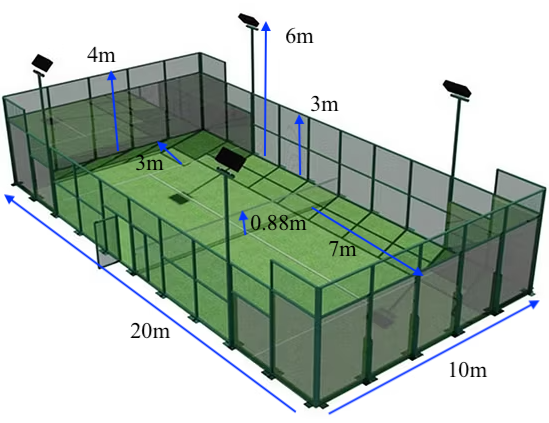Playing Padel in Chicago - Rules
- Alexis.Dtr

- Sep 3
- 4 min read
Updated: Sep 3
Padel is not just another game; it's a thrilling cousin of tennis that has taken the world by storm. With over 10 million players globally and the sport growing by 15% annually, understanding the rules of padel is vital for newcomers and seasoned players alike. This guide will walk you through the fundamental rules of padel, ensuring you're well-prepared to hit the court, whether for informal play or serious competition.

Understanding the padel Court - rules
The padel court is compact, measuring 20 meters long and 10 meters wide, making it easier to cover ground than a traditional tennis court. For our players in Chicago, it's 66 feet long for 33 feet wide. The rules are standard for every court worldwide. The walls surrounding the court are not just barriers - they are crucial for gameplay. Players can hit the ball off these walls to create complex shots that keep their opponents guessing.
A typical court layout includes a service box, which dictates where players must serve from. Knowing the dimensions and features of the court is essential for executing effective strategies during matches.
Scoring System - Chicago variation
Padel follows a tennis-like scoring rule, with points counted as 15, 30, 40, and game. A significant aspect of the scoring is the requirement to win six games to secure a set, and matches are generally played in a best-of-three sets format.
For example, if both teams reach 40-40, known as deuce, the next player must win two consecutive points to clinch the game. This structure adds layers of strategy and makes close matches even more exciting. In fact, about 30% of padel matches go to deuce, showcasing the competitive nature of the sport. Even though in Chicago, many tournaments include the "No-ad" scoring, known as the "Punto de Oro" (Golden point = deciding point), to make the matches shorter. If you're using this No-ad scoring, the team who receive the serve choose which side the point start.
Padel Serving Rules - applied to Chicago area
The serve in padel is distinct and comes with specific rules. Players must stand behind the service line and deliver the ball underhand and the player has to make the ball bounce behind the line (not like our pickelball player here in Chicago), ensuring it lands inside the opponent's service box. For a valid serve, the ball must be struck below the waist.
If the initial serve hits the net but lands correctly, it is regarded as a let serve and replayed. For padel servers, a good serve can dictate the pacing and momentum of the game, making it a critical area to master.
Rallying and Scoring Points - The rules to know
Once the serve is executed, players enter a rally. Each player must hit the ball over the net and into the opponent's side, allowing it to bounce once before their return.
Skillful players can take advantage of the walls, using them to create sharp angles that are hard to predict. Points are won when the opposing team fails to make a successful return, which can happen if they miss the ball, hit it out of bounds, or let it bounce twice. Did you know that in top-level matches, around 40% of points are won through well-executed wall shots?
Faults and Let Serves
In padel, faults are critical to the flow of the game. A serve is considered a fault if the ball does not land in the correct service box or if it fails to clear the net.
A let serve, however, is replayed without penalty, allowing players a second chance. During rallies, if the ball hits the walls or goes out, it results in a point for the opposing team. Being aware of these faults is essential for keeping the game fair and maintaining momentum.
When to know is the ball is out ?
In padel, the ball is considered out when the ball touch directly the walls of the opponent side, when you hit your own fence or hit the ball bounce directly outside the court or touch something who is not part of the court (lights, roof etc).
Also, if the ball touch the wall and the ground at the same time, how do we say if it's In or Out ? It's a manner of angles. If the ball bounce back higher than when the ball came, it's in. If it bounces lower it's out (because it means that the ball touches the ground first).
You will hear a lot of time about the 45° rule, it was 10 years ago, the previous rule.
Conclusion
The rules are pretty simple in padel, same scoring system as tennis, and the ball has to touch the ground first (or the opponent do a volley), otherwise it's out. (Exception for the serve, if the ball bounce on the ground but touch the fence before the second bounce it's out). If the ball touch the ground first, the ball can go to the fences, to the glass or outside the court !



Comments